China correspondent
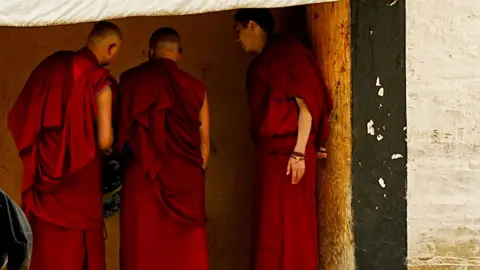 Xiqing Wang/ BBC
Xiqing Wang/ BBCShrouded in crimson robes, prayer beads moving rhythmically past his fingers, the monk walks towards us.
It is a risky decision.
We are being followed by eight unidentified men. Even saying a few words to us in public could get him in trouble.
But he appears willing to take the chance. “Things here are not good for us,” he says quietly.
This monastery in China’s south-western Sichuan province has been at the centre of Tibetan resistance for decades – the world learned the name in the late 2000s as Tibetans set themselves on fire there in defiance of Chinese rule. Nearly two decades later, there are signs the Kirti monastery still worries Beijing.
A police station has been built inside the main entrance. It sits alongside a small dark room full of prayer wheels which squeak as they spin. Nests of surveillance cameras on thick steel poles surround the compound, scanning every corner.
“They do not have a good heart; everyone can see it,” the monk adds. Then comes a warning. “Be careful, people are watching you.”
As the men tailing us come running, the monk walks away.
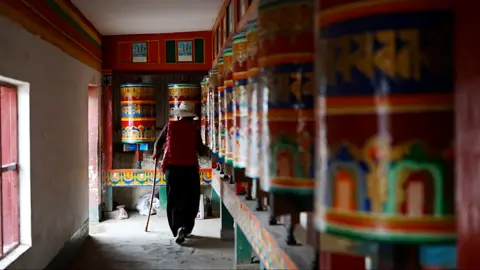 Xiqing Wang/ BBC
Xiqing Wang/ BBC“They” are the Communist Party of China, which has now governed more than six million Tibetans for almost 75 years, ever since it annexed the region in 1950.
China has invested heavily in the region, building new roads and railways to boost tourism and integrate it with the rest of the country. Tibetans who have fled say economic development also brought more troops and officials, chipping away at their faith and freedoms.
Beijing views Tibet as an integral part of China. It has labelled Tibet’s exiled spiritual leader, the Dalai Lama, as a separatist, and those who display his image or offer him public support could end up behind bars.
Still, some in Aba, or Ngaba in Tibetan, which is home to the Kirti monastery, have gone to extreme measures to challenge these restrictions.
The town sits outside what China calls the Tibet Autonomous Region (TAR), created in 1965, comprising about half of the Tibetan plateau. But millions of Tibetans live outside of TAR – and consider the rest as part of their homeland.
Aba has long played a crucial role. Protests erupted here during the Tibet-wide uprising of 2008 after, by some accounts, a monk held up a photo of the Dalai Lama inside the Kirti monastery. It eventually escalated into a riot and Chinese troops opened fire. At least 18 Tibetans were killed in this tiny town.
As Tibet rose up in protest, it often turned into violent clashes with Chinese paramilitary. Beijing claims 22 people died, while Tibetan groups in exile put the number at around 200.
In the years that followed there were more than 150 self-immolations calling for the return of the Dalai Lama – most of them happened in or around Aba. It earned the main street a grim moniker: Martyr’s row.
China has cracked down harder since, making it nearly impossible to determine what is happening in Tibet or Tibetan areas. The information that does emerge comes from those who have fled abroad, or the government-in-exile in India.
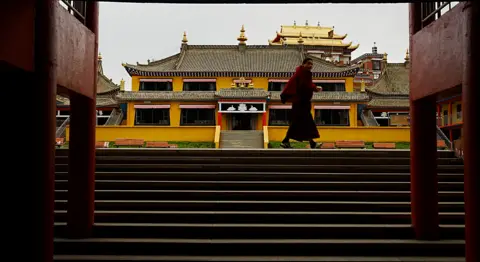 Xiqing Wang/ BBC
Xiqing Wang/ BBCTo find out a little more, we returned to the monastery the next day before dawn. We snuck past our minders and hiked our way back to Aba for the morning prayers.
The monks gathered in their yellow hats, a symbol of the Gelug school of Buddhism. Low sonorous chanting resonated through the hall as ritual smoke lingered in the still, humid air. Around 30 local men and women, most in traditional Tibetan long-sleeved jackets, sat cross-legged until a small bell chimed to end the prayer.
“The Chinese government has poisoned the air in Tibet. It is not a good government,” one monk told us.
“We Tibetans are denied basic human rights. The Chinese government continues to oppress and persecute us. It is not a government that serves the people.”
He gave no details, and our conversations were brief to avoid detection. Still, it is rare to hear these voices.
The question of Tibet’s future has taken on urgency with the Dalai Lama turning 90 this week. Hundreds of followers have been gathering in the Indian town of Dharamshala to honour him. He announced the much-anticipated succession plan on Wednesday, reaffirming what he has said before: the next Dalai Lama would be chosen after his death.
Tibetans everywhere have reacted – with relief, doubt or anxiety – but not those in the Dalai Lama’s homeland, where even the whisper of his name is forbidden.
Beijing has spoken loud and clear: the next reincarnation of the Dalai Lama will be in China, and approved by the Chinese Communist Party. Tibet, however, has been silent.
“That’s just the way it is,” the monk told us. “That’s the reality.”
Two worlds under one sky
The road to Aba winds slowly for nearly 500km (300 miles) from the Sichuan capital of Chengdu.
It passes through the snow-packed peaks of Siguniang Mountain before it reaches the rolling grassland at the edge of the Himalayan plateau.
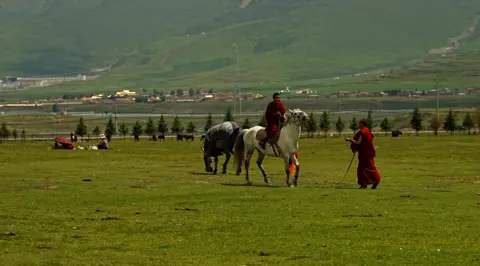 Xiqing Wang/ BBC
Xiqing Wang/ BBC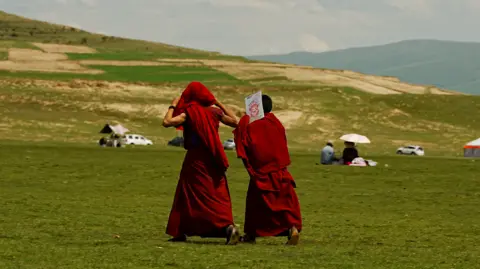 Xiqing Wang/ BBC
Xiqing Wang/ BBCThe gold, sloping rooftops of Buddhist temples shimmer every few miles as they catch especially sharp sunlight. This is the roof of the world where traffic gives way to yak herders on horseback whistling to reluctant, grunting cattle, as eagles circle above.
There are two worlds underneath this Himalayan sky, where heritage and faith have collided with the Party’s demand for unity and control.
China has long maintained that Tibetans are free to practise their faith. But that faith is also the source of a centuries-old identity, which human rights groups say Beijing is slowly eroding.
They claim that countless Tibetans have been detained for staging peaceful protests, promoting the Tibetan language, or even possessing a portrait of the Dalai Lama.
Many Tibetans, inlcuding some we spoke to within the Kirti monastery, are concerned about new laws governing the education of Tibetan children.
All under-18s must now attend Chinese state-run schools and learn Mandarin. They cannot study Buddhist scriptures in a monastery class until they are 18 years old – and they must “love the country and the religion and follow national laws and regulations”.
This is a huge change for a community where monks were often recruited as children, and monasteries doubled up as schools for most boys.
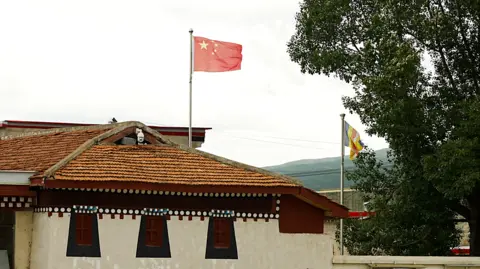 Xiqing Wang/ BBC
Xiqing Wang/ BBC“One of the nearby Buddhist institutions was torn down by the government a few months ago,” a monk in his 60s told us in Aba, from under an umbrella as he walked to prayers in the rain.
“It was a preaching school,” he added, becoming emotional.
The new rules follow a 2021 order for all schools in Tibetan areas, including kindergartens, to teach in the Chinese language. Beijing says this gives Tibetan children a better shot at jobs in a country where the main language is Mandarin.
But such regulations could have a “profound effect” on the future of Tibetan Buddhism, according to renowned scholar Robert Barnett.
“We are moving to a scenario of the Chinese leader Xi Jinping having total control – towards an era of little information getting into Tibet, little Tibetan language being shared,” Mr Barnett says.
“Schooling will almost entirely be about Chinese festivals, Chinese virtues, advanced Chinese traditional culture. We are looking at the complete management of intellectual input.”
The road to Aba shows off the money Beijing has pumped into this remote corner of the world. A new high-speed railway line hugs the hills linking Sichuan to other provinces on the plateau.
In Aba, the usual high-street shop fronts selling monks’ robes and bundles of incense are joined by new hotels, cafes and restaurants to entice tourists.
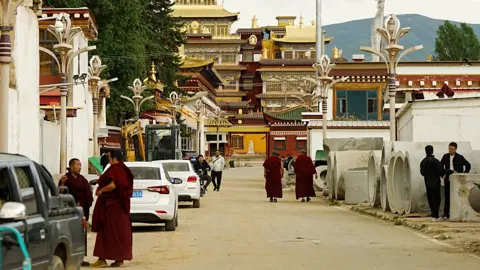 Xiqing Wang/ BBC
Xiqing Wang/ BBC“How do they get anything done all day?” one tourist wonders aloud. Others turn the prayer wheels excitedly and ask about the rich, colourful murals depicting scenes from the Buddha’s life.
A party slogan written on the roadside boasts that “people of all ethnic groups are united as closely as seeds in a pomegranate”.
But it’s hard to miss the pervasive surveillance.
A hotel check-in requires facial recognition. Even buying petrol requires several forms of identification which are shown to high-definition cameras. China has long controlled what information its citizens have access to – but in Tibetan areas, the grip is even tighter.
Tibetans, Mr Barnett says, are “locked off from the outside world”.
The ‘right’ successor
It’s hard to say how many of them know about the Dalai Lama’s announcement on Wednesday – broadcast to the world, it was censored in China.
Living in exile in India since 1959, the 14th Dalai Lama has advocated for more autonomy, rather than full independence, for his homeland. Beijing believes he “has no right to represent the Tibetan people”.
He handed over political authority in 2011 to a government-in-exile chosen democratically by 130,000 Tibetans globally – and that government has had back-channel talks this year with China about the succession plan, but it’s unclear if they have progressed.
The Dalai Lama has previously suggested that his successor would be from “the free world”, that is, outside China. On Wednesday, he said “no one else has any authority to interfere”.
This sets the stage for a confrontation with Beijing, which has said the process should “follow religious rituals and historical customs, and be handled in accordance with national laws and regulations”.
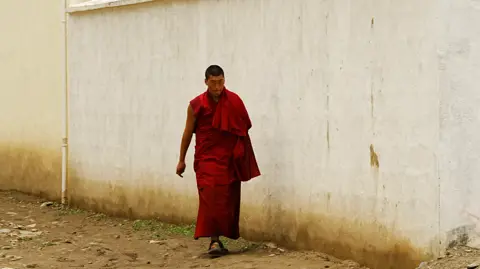 Xiqing Wang/ BBC
Xiqing Wang/ BBCBeijing is already doing the groundwork to convince the Tibetans, Mr Barnett says.
“There is already a huge propaganda apparatus in place. The Party has been sending teams to offices, schools and villages to teach people about the ‘new regulations’ for choosing a Dalai Lama.”
When the Panchen Lama, the second highest authority in Tibetan Buddhism, died in 1989, the Dalai Lama identified a successor to that post in Tibet. But the child disappeared. Beijing was accused of kidnapping him, although it insists that boy, now an adult, is safe. It then approved a different Panchen Lama, who Tibetans outside China do not recognise.
If there are two Dalai Lamas, it could become a test of China’s powers of persuasion. Which one will the world recognise? More important, would most Tibetans in China even know of the other Dalai Lama?
China wants a credible successor – but perhaps no one too credible.
Because, Mr Barnett says, Beijing “wants to turn the lion of Tibetan culture into a poodle”.
“It wants to remove things it perceives as risky and replace them with things it believes Tibetans ought to be thinking about; patriotism, loyalty, fealty. They like the singing and dancing – the Disney version of Tibetan culture.”
“We don’t know how much will survive,” Mr Barnett concludes.
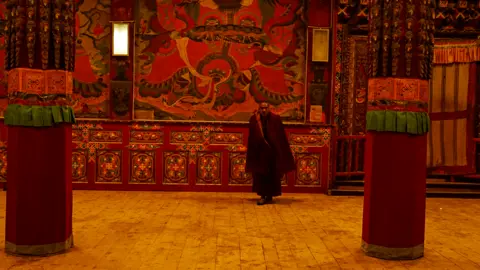 Xiqing Wang/ BBC
Xiqing Wang/ BBC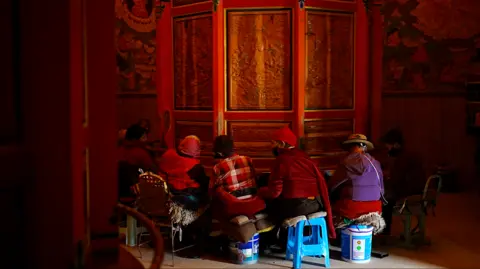 Xiqing Wang/ BBC
Xiqing Wang/ BBCAs we leave the monastery, a line of women carrying heavy baskets filled with tools for construction or farming walk through the room of prayer wheels, spinning them clockwise.
They sing in Tibetan and smile as they pass, their greying, pleated hair only just visible under their sun hats.
Tibetans have clung on to their identity for 75 years now, fighting for it and dying for it.
The challenge now will be to protect it, even when the man who embodies their beliefs – and their resistance – is gone.





